A preliminary study has cited four potential locations for a new building to house both the Vernon Public Art Gallery and Greater Vernon Museum and Archives.
All four sites are municipal-owned properties within Vernon as put forward by Diamond Schmitt Architects, the consulting firm retained by the Regional District of North Okanagan board to work on the building colocation project.
The sites are identified as the Flower Block, located between 31st Ave. and 30th St., which is currently used as a parking lot; the Vernon Block located between 31th Ave. and 32nd Ave.; the site of the Civic Arena, the building set to be demolished with the current intent of the post-arena land use slated forpark space; and Polson Park.
Juliette Cunningham, a Vernon city councillor and chair of the RDNO board, said for her, the Polson Park option is a non-starter because of traffic and parking access issues.
“My preference would be to see the park remain as park,” she said.
“As for the other three options, I don’t have a preference for one over the other at this point.”
AnaMaria Lianos, principal with Diamond Schmitt Architects, said there are many factors that go into choosing a site, including the overall cost and the building design that fits a given location, work that will become the next step in the planning process.
“We have retained a consultant to start to look at specific designs and part of that will include the cost analysis,” said Lianos.
Related: RDNO moves ahead on multi-purpose cultural facility
Asked if privately owned properties were considered, Lianos said that hasn’t been ruled out but the initial preference was looking at public owned properties because it saves on land acquisition costs and is more accommodating for the extended timeline process to completion this project requires.
“We don’t want to close off that option at this stage, but we want to be cautious about the idea of acquiring privately owned property,” Cunningham added.
The report to the RDNO board on Wednesday discussed issues that Diamond Schmitt uncovered in their initial analysis, looking at other similar ventures across North America and meeting with local stakeholders to assemble a priority use of space for a Vernon facility, and of the challenges a shared building between the art gallery and museum would need to address.
Among those challenges would be access to different institutions on different time schedules, how to respect and develop the separate identities of the museum and art gallery and providing meeting space in a new building that is accessible and affordable for other groups to use.
The plus side of the art gallery-museum partnership were identified as operating cost efficiencies, joint admission ticketing which has been reflected in higher attendance and public interaction for similar projects in other communities, and creating an overall gathering place that connects both the community and the specific site interior/exterior assets.
The preliminary net allocation of space would include a net floor square footage of 41,030—12,495 for the art gallery, 20,515 for the museum and 8,020 in shared space.
Cunningham and her board met in-camera with the consultants after Wednesday’s board meeting, and the consultants also met with stakeholders on Tuesday to discuss their initial findings.
“There were some operational questions that came up (at Tuesday’s meeting) but overall the response was pretty positive,” Cunningham said.
She also cited the hope a new home for the art gallery and museum will also provide a side-benefit of additional meeting space for others such as music, dance or other arts groups.
The regional district has budgeted $100,000 to undertake the planning work and is leading the project, with the support and input of other interested stakeholders.
For the Vernon Museum and Archives Society, this project offers a solution for insufficient space currently to house its historical collections and archives, combined with limited space for programming and exhibition initiatives.
The Vernon Public Art Gallery sees the new facility as an opportunity to expand its public programs and space to protect the gallery’s extensive art collection and visiting exhibits.
newsroom@vernonmorningstar.com
Like us on Facebook and follow us on Twitter.
